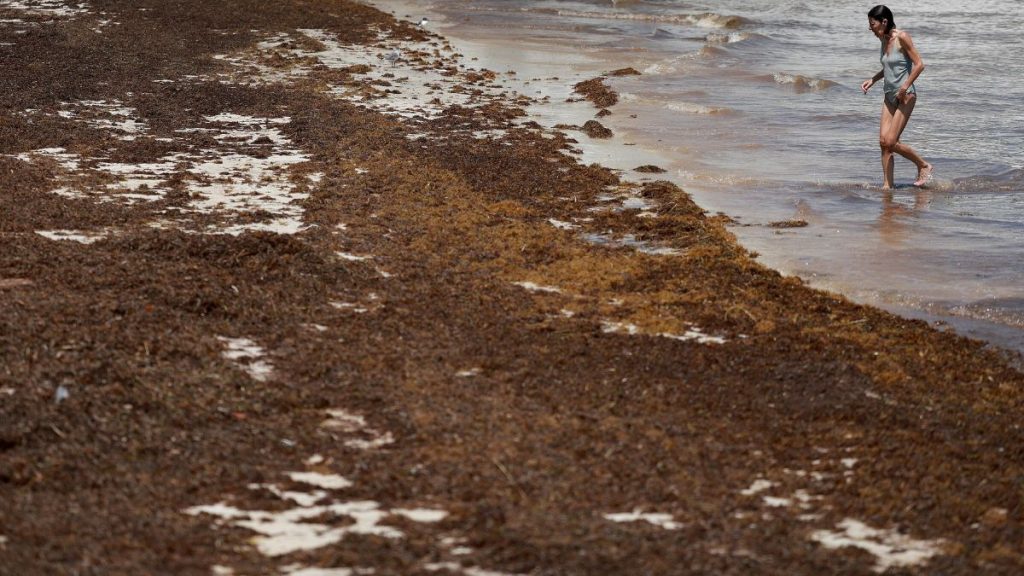A massive seaweed blob packed with bacteria and plastic could be generating a “pathogen storm” in the middle of the Atlantic Ocean, a new study has found. Some news outlets have said that some of the blob-borne bacteria may be a “flesh-eating” species known as Vibrio vulnificus, but experts told Live Science that is not the case.
Originating in the Sargasso Sea in the North Atlantic Ocean, brown algae known as Sargassum have become a growing problem for beachgoers around the world in recent years, as large chunks of the algae have washed ashore. NASA projects that this year’s Sargassum seaweed bloom along the Caribbean and eastern Florida coastlines will be the largest ever recorded, with the bulk of it arriving in June and July.
Sargassum buildups are often smelly, dense and, according to the new study, filled with potentially dangerous bacteria in the genus Vibrio. The researchers published their findings in May in the journal Water Research.
“Clearly, the Vibrio can and does colonize both plastic and Sargassum, and it can carry genes that are potentially pathogenic,” said Linda Amaral-Zettler, a marine biologist at the Royal Netherlands Institute for Sea Research and co-author of the study. “There have been some pretty horrific infections caused by Vibrio. Their flesh-eating potential is rare, but it’s real,” she told Live Science.
Related: How do you know if your cut has flesh-eating bacteria?
About a dozen species of bacteria in the genus Vibrio cause vibriosis, an illness that can occur either when people ingest the bacteria or when the microbes infect an open wound. When eaten, the bacteria can cause severe diarrhea, stomach cramps, fever and vomiting. Regarding the wound infections, one species of Vibrio can sometimes cause so-called flesh-eating infections, scientifically known as necrotizing fasciitis, which rapidly kill the skin around the infected wound.
For the study, the researchers analyzed Sargassum samples from the Caribbean and Sargasso seas, and they did not find V. vulnificus or V. cholerae, the other main Vibrio species that infects humans. V. vulnificus is the only Vibrio species ever known to cause necrotizing fasciitis.
However, the team did identify some previously undescribed Vibrio species that carry key genes found in their disease-causing cousins. The scientists’ analysis suggests that these bacteria potentially also have the “machinery” necessary to infect and cause disease in humans, said Amaral-Zettler.
So what does that mean for beachgoers?
“I don’t think people have to go running screaming away from Sargassum, but they do need to be responsible and realize that there are hazards associated with handling and exposing yourself to these kinds of materials,” Amaral-Zettler said. It’s key to note that Sargassum seaweed masses also contain an abundance of plastic, which Vibrio bacteria can rapidly attach to and proliferate upon within minutes, the study found.
Related: The link between climate change and ‘flesh-eating’ bacteria
The Vibrio in seaweed may have environmental impacts — for instance, like humans, fish can get diarrhea after ingesting Vibrio, and they then release nutrients into the environment, the researchers said. This can lead to an accumulation of Sargassum that can smother coral reefs and suck too much oxygen from the water, causing a “dead zone” where other marine species cannot survive.
However, regarding human health, the presence of Vibrio in the Sargassum isn’t necessarily cause for mass panic.
“This is a good paper in a good journal, but it’s not a huge issue,” said Hidetoshi Urakawa, a microbial ecologist at Florida Gulf Coast University who was not involved in the study. While he stressed that the public should be aware of possible bacteria lurking in the seaweed, Toshi said a lot of Vibrio are harmless. It’s actually good news that the researchers didn’t find the highly pathogenic species of Vibrio that typically infect humans in the Sargassum samples, he added.
That being said, there are also other risks associated with Sargassum blooms once they make landfall, including eye and throat irritation due to toxins released by the rotting seaweed. Currently, Florida government officials do not test Sargassum that washes ashore for Vibrio, but they do warn beachgoers against getting too close to the stinky seaweed. As a precaution against potential threats, including Vibrio infections, people should try to avoid swimming around or touching Sargassum whenever possible, especially when they have open wounds, according to the Florida Department of Health.
Jae Williams, a spokesperson for the Florida Department of Health who was not involved in the new study, emphasized that vibriosis is not contagious.
“What is important is that individuals should take caution,” Williams told Live Science. “They do not need to go play or recreate in the Sargassum, and if you see this Sargassum, just stay away from it.”

